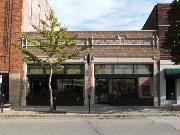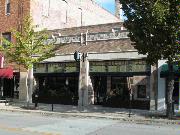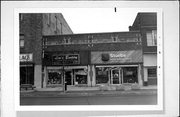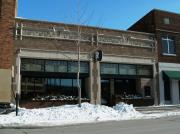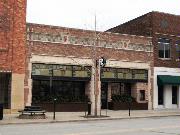Property Record
218-220 N ADAMS ST
Architecture and History Inventory
| Historic Name: | Lucia Building |
|---|---|
| Other Name: | Republic Chophouse |
| Contributing: | Yes |
| Reference Number: | 29463 |
| Location (Address): | 218-220 N ADAMS ST |
|---|---|
| County: | Brown |
| City: | Green Bay |
| Township/Village: | |
| Unincorporated Community: | |
| Town: | |
| Range: | |
| Direction: | |
| Section: | |
| Quarter Section: | |
| Quarter/Quarter Section: |
| Year Built: | 1883 |
|---|---|
| Additions: | 1929 |
| Survey Date: | 19852017 |
| Historic Use: | small retail building |
| Architectural Style: | English Revival Styles |
| Structural System: | Unknown |
| Wall Material: | Brick |
| Architect: | |
| Other Buildings On Site: | |
| Demolished?: | No |
| Demolished Date: |
| National/State Register Listing Name: | Green Bay Downtown Historic District |
|---|---|
| National Register Listing Date: | 5/13/2019 |
| State Register Listing Date: | 2/16/2018 |
| National Register Multiple Property Name: |
| Additional Information: | Two story late commercial vernacular building with altered display windows, now having very wide wooden sign band above. The windows are set between three large brick pilasters having cut stone quoins at their outer edges. The middle of the facade is obscured by the name band, but the decorated frize band above in intact and consists of a broad band having square panels of concrete on which are placed heraldic seals made of bronze. The band has well executed stone coping above and below. The parapet above the band is of brick and is typical with cut stone coping. Formerly the location of Lou's Bootery and Stuebe Office Products. 2017-NRHP District Nomination Per the 1883 Sanborn map of Green Bay, Flatley’s 1-1/2 story livery and carriage house was at this location. An 1883 newspaper article mentions its construction and other articles suggest that the building was completed that same year. Subsequent Sanborn maps appear to show the continuous evolution, as opposed to replacement, of this livery building from a wood frame, brick veneer structure to the building that exists today. In 1900 the Lucia brothers, Albert and William, began operating a bicycle shop out of 220 N. Adams. A third brother, Howard, had opened a similar shop in Oconto, Wisconsin, in 1895. The brothers formed the Lucia Brothers Motor Car Company in 1901 and that same year were responsible for delivering the first automobile in Green Bay. For the next two decades, the Lucia Brothers handled several automobile brands, but by 1921 their dealership became the exclusive dealership for Packard. By 1934 their territory covered twelve counties in Wisconsin and seven in Michigan. Per the City Directories, this building was in use as a car dealership and garage continuously in the years prior to 1929, although the Lucia dealership had moved several years before this. The building presumably remained the property of the Lucia Brothers as the current façade has a carved block at the left side with the year “1929” while a similar carved block at the right side identifies the building as the “LUCiA= BLDG” (note the supposed ‘E’ of ‘LUCiAE’ is depicted as three equal-length horizontal bars with no vertical bar, a possible reference to the three original Lucia brothers, and probably not intended as an ‘E’). Newspaper articles of 1929 through the 1960s generally refer to this building as the “Lucia building” (not “Luciae”). Interestingly, beginning with the 1929 City Directory, interior decorators were the only tenants in the building, suggesting that the 1929 remodel may have been intended to adapt the building for use other than automotive trades. The façade of this two-story brick building has a Tudor Revival (Elizabethan) style. The façade is divided into two storefront bays by three brick pilasters. The central brick pilaster has stone quoin details at both corners, while the two outer pilasters have this quoin detailing only at the storefront corners (and not at the extreme ends of the façade). Molded stone panels sit above each storefront opening. Below these stone panels and between the quoins, the storefronts have been altered. Brickwork above the storefronts extends to a broad concrete frieze. This frieze, near the top of the façade, has a two-row checkerboard pattern of unadorned squares and alternating small rosettes and shields (one shield per two rosettes). Within this frieze, centered above each of the two storefronts, there is a larger shield of red and yellow tile on a concrete panel. Twelve matching tiles in a checkerboard arrangement are at the center of the frieze, centered on the façade, as are an additional eight tiles at either end of the frieze. These three groups of checkerboard tile are set off from the rest of the frieze by stone mullions with capitals above and pendants below. A stone moulding frames the top and bottom of the frieze. There is a narrow band of brickwork above the frieze, which is topped with a round profile coping. Despite the altered storefronts, this building retains a high degree of integrity. This building is one of several in the district that have received new façades during the historic period. This building is also closely connected to the early automotive history of Green Bay. |
|---|---|
| Bibliographic References: | (A) Plaque on building facade. (B) Inscription. (C) Daily State Gazette. Green Bay, Wisconsin. 17 May 1883, page 4. (D) “Lucia Brothers,” Oconto County Historical Society, accessed 02 Feb 2017, http://www.ocontoctyhistsoc.org/lucia-brothers |
| Wisconsin Architecture and History Inventory, State Historic Preservation Office, Wisconsin Historical Society, Madison, Wisconsin |

